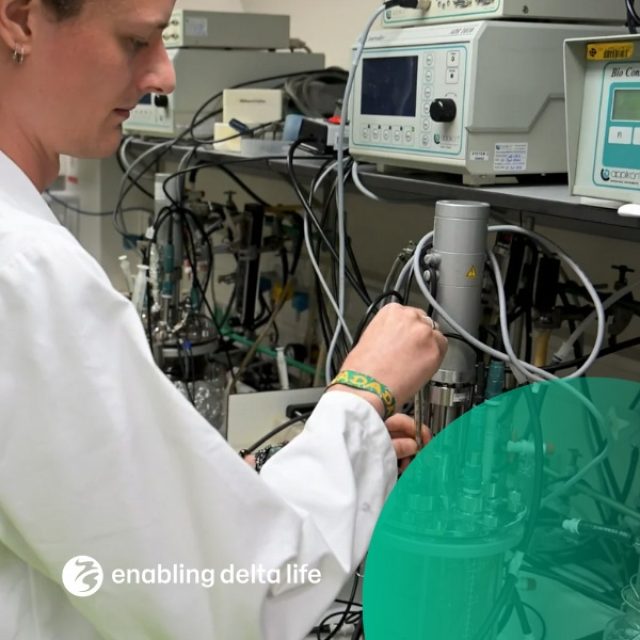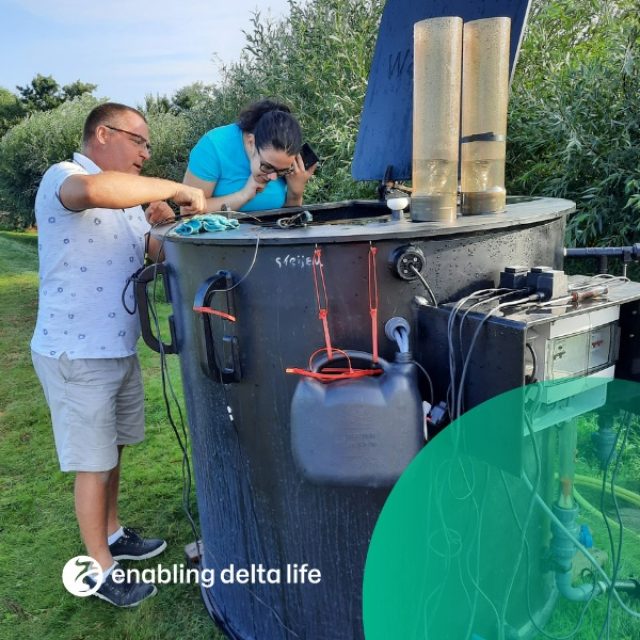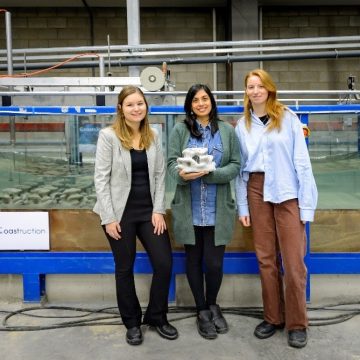Practical examples of the SME challenge
On this page, you will find concrete examples of previous participants in the SME challenge who, with the assistance of Deltares, have elevated their design concepts of innovations to a higher level. These success stories are intended to inspire and encourage you to participate in the upcoming edition of the SME challenge. At Deltares, we strongly believe in the power of collaboration and innovation. Our experts are ready to support you and test your design concepts.

Hydro facilities
The Scheldt Flume, also known as Scheldt flume, is a transparent Plexiglas flume where innovative coastal and offshore designs can be exposed to waves. Examples of innovative initiatives that can be tested include; artificial reefs, coastal and bottom protection and rock settlements.
The Water and Soil Flume is frequently used by our partners from the marine and energy sector and dredging and mining industry. The large-scale facility is the go-to research flume for soil-related R&D projects and innovations. Unique features of the water and soil flume include; the rail system motor car, the 'clay factory', the hexapod platform, a Plexiglas flume and the availability of numerous measuring instruments. Examples of innovative initiatives that can be tested include; (deep sea) cutting and suction heads, anchors, sprayers, plume dispersion, 'bubble screens', monopile installation, stability and so on. The Atlantic basin can be used for coastal, river, port and offshore projects.
Case study Weco SME challenge

Weco is een startup bedrijf gerund door drie jonge en enthousiaste afgestudeerden van de TU Delft, Universiteit Wageningen en Utrecht. Hun product is een Wave Energy Converter. Om de volgende stap naar de praktijk te maken, schreef het bedrijf zich in voor de mkb challenge van Deltares. Toen ze waren geselecteerd, kreeg Weco toegang tot de Scheldegoot. In de goot werd het gedrag van het apparaat getest. Luc Hogervorst, medeoprichter Weco over het project: 'We waren erg blij dat we onze Wave Energy Converter bij Deltares konden testen in de Scheldegoot, waar het mogelijk was om zowel golven als stroming op te wekken.'
At Deltares, we learned a lot about our Wave Energy Converter, which allowed us to take the next step in the design process..
Luc Hogervorst, co-founder Weco
Laboratoria
At the geochemistry and microbiology lab, a lot of experimental research is done on, among other things, the biodegradation of (future) contaminants, think of PFAS, microplastics. Research is also conducted into microbial corrosion of steel infrastructure and development of new monitoring techniques for organic and microbial contaminants. It also studies (geochemical) processes in, for instance, sediment applications and the composition of organic material. The lab also has facilities for performing anaerobic microbiological research, DNA/RNA analyses (at population and gene level), hydrogen analyses and the measurement of nutrients and also greenhouse gases both in the lab and live in the field.
The physical lab also does provide a playing field for research into new (measurement) techniques. There are a number of standard measuring instruments that can be used for different purposes. With minor adjustments to instrument or (water,soil) sample or other sample preparation, nice results can be obtained.
Case study T&K SME challenge

T&K Service collaborates with Deltares in innovative soil remediation projects. To tap a new market, micro-organisms are selected and grown in a bioreactor for the degradation of aromatic compounds. With the SME Challenge, a bioreactor has been made available to T&K to investigate whether a population of bacteria can be acquired that can break down contaminants such as benzene, toluene, ethylbenzene and xylenes (BTEX). T&K can then add a biological step to its chemical oxidation method for these contaminants.
We can thus improve the effectiveness of soil remediation and significantly reduce costs.
Nanne Hoekstra, Soil and groundwater quality expert at Deltares
Field facilities
Deltares has unique in-situ geophysical measurement and monitoring techniques for the subsurface and surface, on land and at sea. Applications of the techniques include mapping (determination of subsurface structure), detection of (un)natural obstacles and risk mitigation in construction projects. These techniques make it possible to monitor innovations in the field, on a large scale.
We also have facilities at our disposal where we can conduct controlled experiments. In addition, Deltares continuously measures water quality at a number of locations in the Netherlands. At Vuursteentocht and Vinkenloop, for instance, nutrients in surface water are measured with high time resolution. These 'controlled' locations can be used by SME initiatives, for example, to test new measurement techniques.
Case study WaterQi SME challenge

The WaterQi is a device that generates very small bubbles to increase the amount of oxygen in ditches and lakes. In addition, the WaterQi produces concentrated 'foam' through the bubbles. The SME challenge provided an opportunity to investigate which contaminants were collected in the foam. Among other things, it was found that the foam had a higher concentration of PFAS than the water at the inlet. So this could be a promising solution to improve water quality. With the WaterQi, we are working on ecological restoration and improving water quality with nanobubbles'.
The research at Deltares produced recommendations to increase the effectiveness of the method.
Ben de Vos, WaterQi
Geo facilities
Deltares' Geotechnical Laboratory specialises in performing complex, advanced standardised tests (such as cyclic triaxial, compressive and shear tests) and developing and conducting non-standard experiments in order to determine soil parameters under specific conditions or conduct experiments in conjunction with the execution of large-scale field experiments.
The GeoCentrifuge is a special facility. Because gravitational forces (g-force) can be generated up to as much as 150 g as the centrifuge spins around, actual sizes can be scaled. The size of the machine means that structures such as dykes, railway tracks and wind turbines can be tested and effects such as subsidence and climate change measured in the ground.
The Geohal houses a large number of generic set-ups that enable scale tests of soil and soil-construction interaction. Here, we can determine the static and dynamic properties of soil and soil-construction interaction under conditioned conditions and validate and optimise soil-mechanical designs with the results.
Related initiatives
This year, SLAMDAM will have the unique opportunity to test their inflatable barrier in Deltares' Delta flume. A test has already been done to see if the barrier fits in the flume and how long it takes to set up and remove the barrier. The real wave tests will be carried out this autumn and are going to show what wave heights the barrier can withstand.



